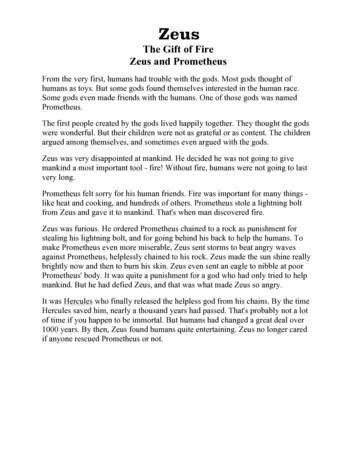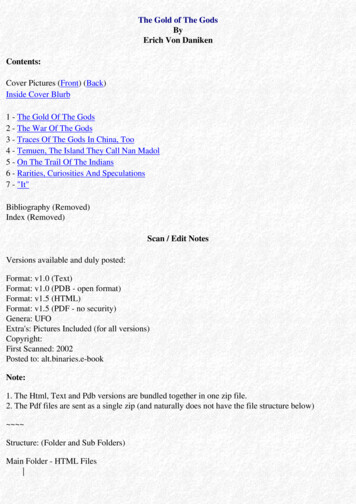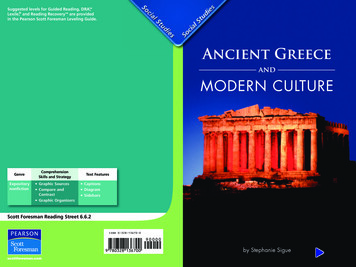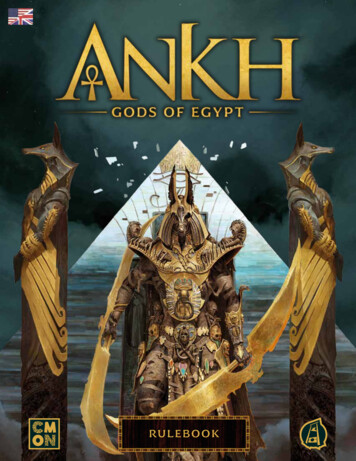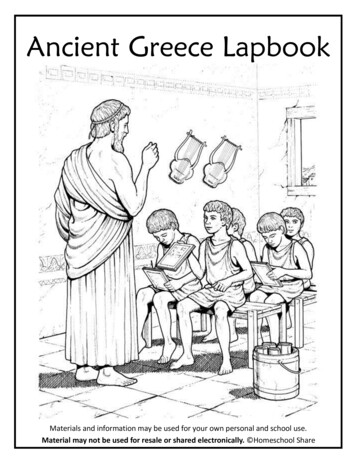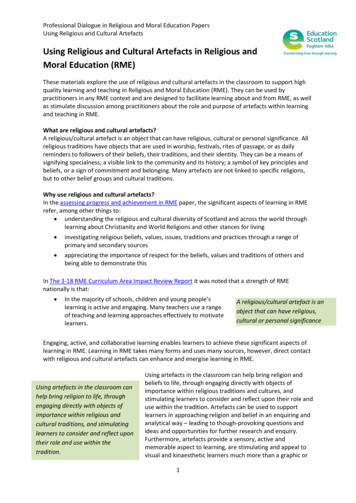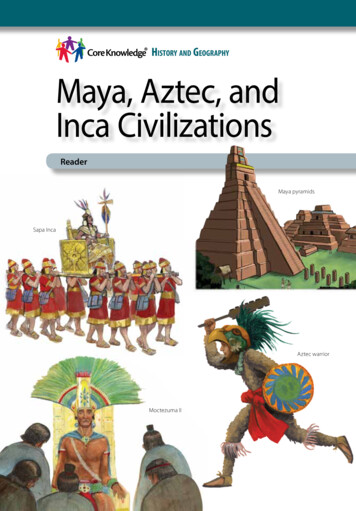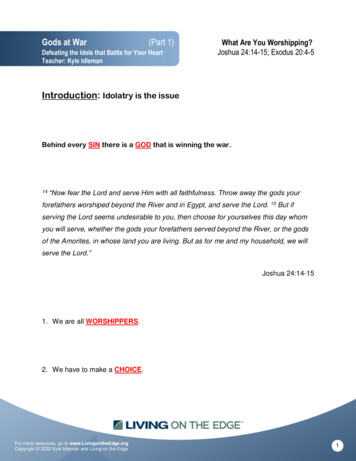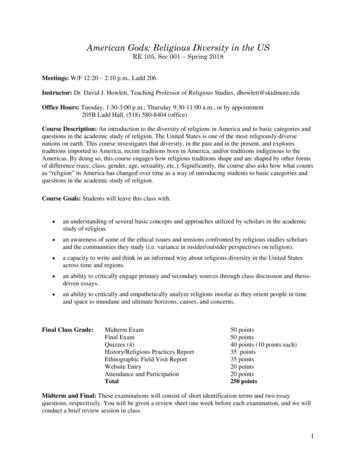
Transcription
American Gods: Religious Diversity in the USRE 105, Sec 001 – Spring 2018Meetings: W/F 12:20 – 2:10 p.m., Ladd 206Instructor: Dr. David J. Howlett, Teaching Professor of Religious Studies, dhowlett@skidmore.eduOffice Hours: Tuesday, 1:30-3:00 p.m.; Thursday 9:30-11:00 a.m., or by appointment205B Ladd Hall, (518) 580-8404 (office)Course Description: An introduction to the diversity of religions in America and to basic categories andquestions in the academic study of religion. The United States is one of the most religiously diversenations on earth. This course investigates that diversity, in the past and in the present, and explorestraditions imported to America, recent traditions born in America, and/or traditions indigenous to theAmericas. By doing so, this course engages how religious traditions shape and are shaped by other formsof difference (race, class, gender, age, sexuality, etc.). Significantly, the course also asks how what countsas “religion” in America has changed over time as a way of introducing students to basic categories andquestions in the academic study of religion.Course Goals: Students will leave this class with: an understanding of several basic concepts and approaches utilized by scholars in the academicstudy of religion. an awareness of some of the ethical issues and tensions confronted by religious studies scholarsand the communities they study (i.e. variance in insider/outsider perspectives on religion). a capacity to write and think in an informed way about religious diversity in the United Statesacross time and regions. an ability to critically engage primary and secondary sources through class discussion and thesisdriven essays. an ability to critically and empathetically analyze religions insofar as they orient people in timeand space to mundane and ultimate horizons, causes, and concerns.Final Class Grade:Midterm ExamFinal ExamQuizzes (4)History/Religious Practices ReportEthnographic Field Visit ReportWebsite EntryAttendance and ParticipationTotal50 points50 points40 points (10 points each)35 points35 points20 points20 points250 pointsMidterm and Final: These examinations will consist of short identification terms and two essayquestions, respectively. You will be given a review sheet one week before each examination, and we willconduct a brief review session in class.1
“Open Student” Quizzes: Over the course of the semester, you will have four quizzes over the readings.Unlike most quizzes in most courses, you will have time to consult with your classmates on the quiz. Thequiz will consist of 5 questions, drawn from the readings since the last quiz. In the first ten minutes, youwill answer the questions on your own. In the second ten minutes, you may consult any students in theclass for assistance. The quiz is not “open notes,” but it is “open student.” This assessment activity isintended to develop your understanding of the material, as well as develop problem solving skills inconsultation with a group.Religious Pluralism in New York’s Capitaland: Our class is part of a multi-semester project that willbe researching religious pluralism in New York’s Capitaland region (the greater Albany area). Thisproject will consist of several parts, spread over the semester.In the second week of the semester, you will be assigned to research a particular religious tradition. Forour section of this course, we will be researching Buddhism, Sikhism, new religious movements, andChristian traditions in the Capitaland region. Students who take this course in subsequent semesters willresearch other traditions.1) History and Religious Practices Report. You will complete an initial report on the backgroundof the group you are studying. This will include a section on religious practices and beliefs of thegroup, as well as a very brief history of this group in the US. For this assignment, you will needto consult at least three reputable academic secondary sources (journal articles, books, or bookchapters). These sources may not include internet sites, though the journal articles, books, or bookchapters potentially could be accessed by electronic means. This project will be between 3-5pages in length. For a few suggested readings as well as detailed requirements for your report, seethe Blackboard site. (Due 10/10)2) Ethnographic site visit report. You will find a place of worship or cultural center for yourparticular assigned tradition and conduct an ethnographic field visit of the site at a time when itwelcomes visitors. You will take notes about your visit (either during or after the visit, dependingthe appropriateness of this). Then, you will use your notes to construct a site visit report. Thisreport has two main sections: (1) a section recording your observations, and (2) a section ofanalysis that integrates a reading from the syllabus and one of the readings that you have used foryour background report. The length for your site visit report should be between 3-5 pages. Adetailed write-up of the requirements for this assignment is on your Blackboard site. (Due 11/2)3) Website Page. This final project asks you to take your previous two reports and condense theminto an 800-word entry with three sections: (1) a brief description of the site you visited, (2) abrief history of the site, and (3) information about when it is best to visit the site if you are avisitor, complete with the norms you should observe to be a good guest. This final report shouldbe submitted in written form as a hard copy and then uploaded to our website. In addition, youwill need to upload a photo that you took of the exterior of the site. If your site hosts allow forinterior shots, you may do so, though you should not have people in these photos (each person inthe photo would have to sign a release form to do so). Finally, you will place a pin on ourcollective google map on our website that shows the location of your site. (Due 11/28)Attendance and Participation: Students are expected to attend every class and participate in classdiscussions. Students are expected to arrive on time. If a student is ten or more minutes late, he or she will2
be counted as absent, even if he or she attends the rest of class. If a student misses four classes, he or shemay have his or her final grade dropped by one full letter grade. If a student misses eight classes, he orshe may be expelled from the course. Each class will have a daily question or exercise that students areexpected to complete in the first few minutes of class. Daily questions will be collected at the time of themidterm and at the last class of the semester.Assessment of Student Work: Students will be subject to a standard grading scale as follows:A 97-100%A94-96%A90-93%B 87-89%B84-86%B80-83%C 77-79%C74-76%C70-73%D 67-69%D60-66%D56-59%F55 and belowThere is no curve for this class. A student will receive the grade he or she earns.Classroom Procedures and Policies:Academic Dishonesty: Skidmore College’s Academic Integrity Handbook, 2016-2017 defines plagiarismand its consequences as follows:Presenting as one’s own, the work of another person (for example, the words, ideas, information,data, evidence, organizing principles, or style of presentation of someone else). Plagiarismincludes paraphrasing or summarizing without acknowledgment, submission of another student’swork as one’s own, the purchase of prepared research or completed papers or projects, and theunacknowledged use of research sources gathered by someone else. Failure to indicate accuratelythe extent and precise nature of one’s reliance on other sources is also a form of plagiarism. Thestudent is responsible for understanding the legitimate use of sources, the appropriate ways ofacknowledging his or her academic, scholarly, or creative indebtedness, and the consequences forviolating the Skidmore Honor Code. THE JUDICIAL BOARDS OF THE COLLEGE WILLNOT REGARD CLAIMS OF IGNORANCE, OF UNINTENTIONAL ERROR, AND OFACADEMIC OR PERSONAL PRESSURES AS AN ADEQUATE DEFENSE FORVIOLATIONS OF THE HONOR CODE.1Further information on the college-wide policy on plagiarism and proper citation methods may be foundon pages 16-27 of The Academic Integrity Handbook.Late Assignment Policy: Any paper not given to the instructor in person by the student on the due date islate and will have its grade automatically dropped by one full letter grade. A student will have forty-eighthours to e-mail the instructor a copy of the late paper. (The student must still submit a hard copy.) Any1Academic Integrity Handbook, 2016-2017 (Saratoga Springs, New York: Office of Academic Advising-Skidmore College, 2016), 8.3
paper that is not given to the instructor within forty-eight hours of the due date will not be accepted, andthe offending student will receive a zero for that assignment.Accommodations for Students: If you are a student with an approved accommodation for your courses,please see me in private or e-mail me about the agreement that has been worked out with the Coordinatorof Student Accessibility Services. If you do not have a documented accommodation and need one, contactMeg Hegener, Coordinator of Student Access Services. You will need to provide her office withdocumentation which verifies the existence of a disability and supports your request. For furtherinformation, please call 580-8150 or stop by the Office of Student Academic Services in Starbuck Center.Sexual- and Gender-based Misconduct and Title IX Rights: Skidmore College considers sexual andgender-based misconduct to be one of the most serious violations of the values and standards of theCollege. Unwelcome sexual contact of any form is a violation of students’ personal integrity and theirright to a safe environment and therefore violates Skidmore’s values. Sexual and gender-basedmisconduct is also prohibited by federal regulations. Skidmore College faculty are committed tosupporting our students and upholding gender equity laws as outlined by Title IX. If a student chooses toconfide in a member of Skidmore’s faculty or staff regarding an issue of sexual or gender-basedmisconduct, that faculty or staff member is obligated to tell Skidmore’s Title IX Coordinator or Title IXDeputy Coordinator. The Title IX Coordinator or Deputy Coordinator will assist the student inconnecting with all possible resources for support and reporting both on and off campus. Identities anddetails will be shared only with those who need to know to support the student and to address the situationthrough the college’s processes. If the student wishes to confide in a confidential resource, TheCounseling Center Staff, Health Services, and Victim Advocates are all options available. Moreinformation can be found at https://www.skidmore.edu/sgbm/ or by contacting the Title IX Coordinator orDeputy Coordinator.Work Expectations: Students should expect nine to ten hours of outside preparation work for class eachweek. On written assignments, successful students distribute their workloads over the course of a weekrather than cram their writing into the night before the due date. Be a successful student.Textbook (available for purchase at the Skidmore Shop) Michael Pasquier, Religion in America: The Basics (New York: Routledge, 2016).ISBN-13: 978-11388055764
SCHEDULE OF WEEKLY TOPICS & STUDENT READING ASSIGNMENTSRLST 105 - Spring Semester 2018All assignments are to be read before each class. The instructor reserves the right to make changesto the reading schedule. Should changes be made, students will be informed in advance.WEEK 1Course Introduction(1/24-1/26)Topics:Course outline; overview of contemporary American religious diversity; “diversity”and “pluralism” as key concepts; overview of religions in colonial America; NativeAmerican vs. Euro-American cosmologiesReadings:1) Michael Pasquier, “Religion and Colonialism in Early America, 1400-1770s,”in Religion in America: The Basics (New York: Routledge, 2016), 25-57.Unit I: Religious Power in Colonial AmericaWEEK 2Lived Religion in Colonial America(1/31 – 2/2)Topics:Pueblo cosmology; “lived religion” as an analytic term; Puritan cosmology;witchcraft and the Devil in colonial New England; “strategies” and “tactics” asanalytic conceptsReadings:1) Ramon A. Gutierrez, “The Pueblo Indian World in the Sixteenth Century,” inReligion and American Culture: A Reader, ed. by David G. Hackett (New York:Routledge, 2003), 3-27.2) Anne S. Brown and David D. Hall, “Family Strategies and Religious Practice:Baptism and the Lord’s Supper in Early New England,” in Lived Religions in America:Toward a History of Practice (Princeton: Princeton University Press, 1997), 41-68.WEEK 3Lived Religion in Colonial America, cont’d.; Gendering Religion(2/7 – 2/9)Quiz 1 (2/7)Islam in colonial America; “slave religion”; “cultural hegemony,” “public transcript,”and “hidden transcript” as analytic concepts; Mohican Christianity and gender;“interest theory” versus “strain theory” and conversionTopics:Readings:1) Jeffry R. Halverson, “West African Islam in Colonial and Antebellum SouthCarolina,” Journal of Muslim Minority Affairs 3.3 (2016): 1-14. [Blackboard]2) Rachel Wheeler, “Mohican Men and Jesus as Manitou,” in To Live Upon Hope:Mohicans and Missionaries in the Eighteenth-Century Northeast (Ithaca, New York:Cornell University Press, 2008), 105-132.5
WEEK 4Gendering Religion, cont’d.Quiz 2 (2/16)(2/14 – 2/16)Topics:colonial-era Judaism; material culture as religious medium; “agency” of materialobjects and religion; overview of religion in antebellum AmericaReadings:1) Ellen Smith, “Portraits of a Community: The Image and Experience of EarlyAmerican Jews,” in American Jewish Women’s History: A Reader, ed. by Pamela SusanNadell (New York: New York University Press, 2003), 13-25.2) Pasquier, “Religion in a New Nation, 1770s-1860s,” in Religion in America, 58-85.Unit II: Prophets and Civil ReligionsWEEK 5(2/21 – 2/23)Prophets and New Religious MovementsHistory/Religious Practices Report Due (2/23)Topics:Prophets and prophecy in antebellum America; sociological versus historicalapproaches to new religious movements; insider versus outsider positionality;“habitus,” “field,” “practice,” “mazeway stress” and “revitalization movements” asanalytic conceptsReadings:1) Richard H. Broadhead, “Prophets in America circa 1830: Nat Turner, Ralph WaldoEmerson, and Joseph Smith,” in Joseph Smith: Reappraisals after Two Centuries (NewYork: Oxford University Press, 2009), 13-30. [Blackboard]2) James R. Lewis, “Shamans and Prophets: Continuities and Discontinuities inNative American New Religious Movements,” American Indian Quarterly 12.3 (1988):221-228. [Blackboard]WEEK 6(2/28 – 3/2)Religion in the “Gilded Age”; Civil Religion and PowerTopics:Overview of religious diversity in post-Civil War America; women and reformmovements; race, power, and the ritual memorialization of the Confederacy; postCivil War African American churches; “collective memory,” “mediating structures,”and “civil religion” as analytic conceptsReadings:1) Pasquier, “Religion in a Modernizing America, 1860s-1920s,” Religion in America,85-109.2) Charles Reagan Wilson, “The Religion of the Lost Cause: Ritual and Organizationof Southern Civil Religion,” Journal of Southern History 46.2 (1980): 219-238.[Blackboard]6
WEEK 7(3/7 – 3/9)Consumer Religion and HolidaysMidterm (3/9)Topics:Religion, fashion, and consumption; “commodification” as an analytic concept;religion as “watch” and “compass”Readings:2) Leigh Eric Schmidt, “The Easter Parade: Piety, Fashion, and Display,” Religion andAmerican Culture: A Journal of Interpretation 4.2 (1994):135-164. [Blackboard]WEEK 8(3/14 – 3/16)NO CLASS: Spring VacationUnit III: Forming Categories and Constructing DifferenceWEEK 9(3/21 – 3/23)Marginality and Racializing ReligionTopics:Jewish marginality and African American exclusion; cultural appropriation; Islamand new religious movements; religion and the body; “sensorial religion,” “mimesis”and “alterity,” “strategies” and “tactics” as analytic conceptsReadings:1) Michael Alexander, “ ‘Mammy, Don’t You Know Me’: Al Jolson and the Jews,” inJazz Age Jews (Princeton: Princeton University Press, 2001), 130-179.2) Judith Weisenfeld, “Spiritual Complexions: On Race and the Body in theMoorish Science Temple of America” in Sally Promey, ed., Sensational Religion: Senseand Contention in Material Practice (New Haven: Yale University Press, 2014), 413-428.WEEK 10(3/28 – 3/30)Claiming Religious Status, Constructing Religion as a CategoryEthnographic Field Visit Report Due (3/28)Topics:“Religious freedom” as a contested term; the shifting boundaries of “religion” inAmerica; “genealogical” approaches to studying religion; the origins of the “worldreligions” framework and “Hinduism”; “de facto congregationalism” and “adoptersvs. inheritors” as analytic conceptsReadings:1) Tisa Wenger, “ ‘We Are Guaranteed Religious Freedom’: Pueblo Indians and theCategory of Religion in the 1920s” History of Religions 45.2 (2005): 89-113.2) Michael J. Altman, “The Construction of Hinduism in America,” Religion Compass10.8 (2016): 207-216.7
Unit IV: A New Religious AmericaQuiz 3 (4/4)WEEK 11(4/4 – 4/6)Materializing ReligionTopics:Overview of religion in the “short twentieth century”; growing up Catholic inAmerica; “childhood” and religion in America; “age” as a category of difference;“materialization” or “corporealization” of religion as analytic conceptsReadings:1) Pasquier, “Religious Diversity in a Globalizing America, 1920s-2010s,” 110-142.2) Robert Orsi, “Material Children: Making God’s Presence Real for CatholicBoys and Girls and the Adults in Relation to Them,” in Between Heaven and Earth: TheReligious Worlds People Make and the Scholars Who Study Them (Princeton: PrincetonUniversity Press, 2005), 73-109. [Blackboard]WEEK 12(4/11 – 4/13)Topics:Materializing Religion, cont’d.; Religious Intolerance, Religious AdaptationReadings:1) Jenna Weissman Joselit, “Kitchen Judaism” in The Wonders of America: ReinventingJewish Culture, 1880 1950 (New York: Hill and Wang, 1994), 171-218. [Blackboard]Foodways and religion in America; “kosher-style” Judaism; Islam in post-50sAmerica; the Nation of Islam; immigration and Islam; Islamophobia; “Islamization”and “glocalization” as analytic concepts2) Edward E. Curtis, IV, “The Black Muslim Scare of the Twentieth Century: TheHistory of State Islamophobia and Its Post-9/11 Variations,” in Islamophobia inAmerica: The Anatomy of Intolerance, ed. by Carl W. Ernst (New York: Palgrave, 2013),75-106. [Blackboard]WEEK 13(4/18 – 4/20)Religion Crossing BordersTopics:Western Buddhism; religion and region as categories of analysis; “vicarious religion”and the “Aunt Susan” principle as analytic concepts; gender and Latinx Catholicism;religion and borderlandsReadings:1) Jeff Wilson, “Buddhism with a Southern Accent: American Buddhists in aSouthern Culture,” Dixie Dharma: Inside a Buddhist Temple in the American South(Chapel Hill: University of North Carolina Press, 2012), 153-185.Website Entry Due (4/18)2) Kristin Nabhan Warren, “Little Slices of Heaven and Mary’s Candy Kisses:Mexican American Women Redefining Feminism and Catholicism,” in The ReligiousHistory of American Women: Reimagining the Past, ed. Catherine A. Brekus (Universityof North Carolina Press, 2007), 294-318. [Blackboard]8
WEEK 14(4/25 – 4/27)“Nones” and “Somes”: Contemporary Trends in American ReligionsTopics:Spiritual-but-not-religious Americans; secularization theories; the future of religiousgroups in America; religious affiliation, political affiliation, and polarization;“secularity” and “implicit religion” as analytic termsReadings:1) Elizabeth Drescher, “Introduction: An American Spiritual Pilgrimage” and“Conclusion: The Noneing of American Religion and Spirituality,” in Choosing OurReligion: The Spiritual Lives of America’s Nones (New York: Oxford University Press,2016), 1-15, 246-252. [Blackboard]Quiz 4 (4/25)2) Mark Chaves, “Polarization” and “Conclusion” in American Religion: ContemporaryTrends (Princeton, New Jersey: Princeton University Press, 2011), 94-114.[Blackboard]FINAL Exam – May 7, 1:30 p.m., Ladd 2069
American Gods: Religious Diversity in the US RE 105, Sec 001 - Spring 2018 . or book chapters). These sources may not include internet sites, though the journal articles, books, or book chapters potentially could be accessed by electronic means. This project will be between 3-5 pages in length. For a few suggested readings as well as .
